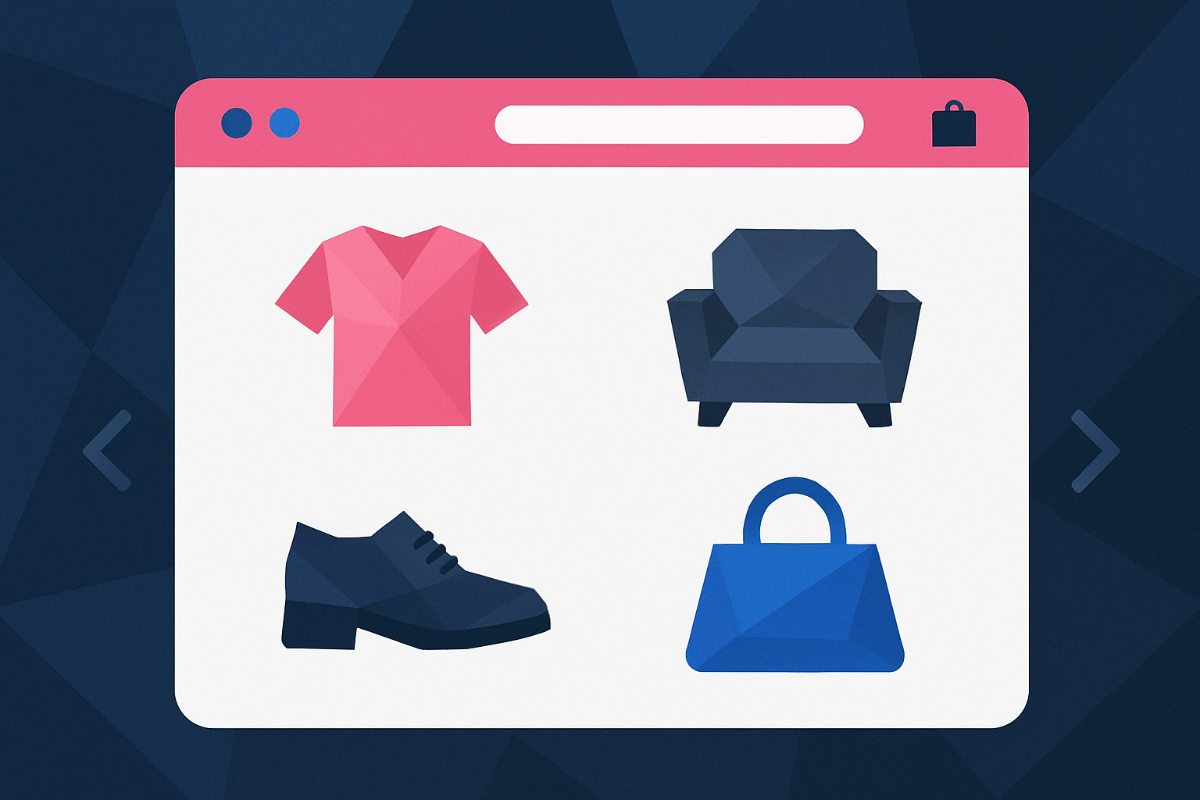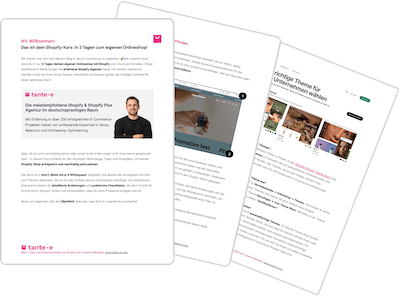Category pages are among the most important sections in Shopify stores. They are often the first point of entry to the product range: They provide orientation, facilitate decision-making, and can lead to targeted sales. At the same time, they are an important SEO lever for attracting new visitors through generic search terms.
Retailers who work with a clear structure, relevant information, and targeted user guidance not only increase conversion rates but also visibility. In this article, we've compiled our experiences on what characterizes successful category pages or collections in Shopify and how popular brands approach this.

Shopify expert Adrian has already helped numerous brands with e-commerce issues. He regularly shares practical knowledge in the tante-e podcast together with our other experts. This article is based on the episode on best practices for category pages on Shopify ( YouTube / Spotify / Apple Podcast ).
- What is a category page and why is it so important for Shopify stores?
- The most important tasks of an optimized category page
- Classic collections vs. theme worlds
- The most important elements of a convincing category page
- Do's & Don'ts: Avoid common mistakes on category pages
- Shopify-specific tips for category pages
- Best practice examples from Shopify stores
- Conclusion: Category pages as a strategic conversion and SEO lever
1. What is a category page and why is it so important for Shopify stores?
In Shopify, the category page is technically a so-called collection. Here, products are grouped together by a specific topic or product type and displayed in a fixed layout. In the admin area, you can assign a template, link the page in the menu, and add filters or sorting options.
From a customer's perspective, however, a category page is much more than just a technical product list. It is often the first point of contact for navigating the product range. It fulfills the following functions:
- Overview of all relevant products on a topic
- First information directly from the product preview
- Comparability between different articles
- Quick access to suitable filters or subcategories
In short: Category pages should lead visitors directly to the product they are looking for or inspire them to make a suitable selection.
In our experience, the potential of category pages is often underestimated. Not only are they part of the user journey, but they are often one of the first pages potential customers see—whether through a Google search, a performance marketing campaign, or a link from social media.
Because category pages often rank for generic keywords like "buy protein bars," "ergonomic office chair," or "women's leather bag," they are particularly relevant for organic visibility. Well-optimized category pages therefore combine two goals:
- Search engines signal which search queries they are relevant for.
- Convince users to proceed directly with the purchasing process.
2. The most important tasks of an optimized category page
A successful category page essentially fulfills three tasks – all with a direct impact on conversion rate, user experience and SEO.
2.1. Creating orientation
Visitors need to understand at a glance which products they'll find on the site. Clear titles, understandable descriptions, and a logical layout help them understand the product range. For example, visitors who immediately recognize that they'll find "office chairs for home offices and workstations" are more likely to stay on the site and click further.
2.2. Facilitate decisions
The more relevant information is visible directly in the product preview on the category page, the fewer clicks are required. Information about price, variants, special features (e.g., material, size, seal), or social proof through reviews help customers compare products directly without having to navigate to the product detail page each time. This reduces bounce rates and speeds up the purchase process.
2.3. Enable the direct route to the product
The category page is a central hub in the user journey. Good navigation, precise filters, and sensible sorting lead users to their desired product more quickly.
Why this is important:
- For customers: Less search effort, faster purchase decisions, better buying experience.
- For SEO: More interaction, lower bounce rates and longer dwell time signal relevance to search engines.
- For conversions: Fewer hurdles mean more completed purchases.
3. Classic collections vs. theme worlds
Not every shop visitor knows exactly what product they want to buy. Traditional category structures, such as product types like "protein bars" or "office chairs," work well for targeted searches, but fall short when customers are looking for a solution or inspiration.
Our recommendation here is to integrate themed worlds into your store. Instead of sorting products exclusively by type or function, you can group them based on goals, use cases, or pain points. Practical examples:
- Goal-oriented: “Build muscle,” “Eat healthier,” “Travel sustainably”
- Application-based: “Equipment for kitesurfers,” “Safety for families in the water”
- Style-based: “Minimalist interior”, “Boho look”
The following advantages result from organizing by topic:
- Customers feel more directly addressed because the introductions address their motivation.
- Newcomers to the product range receive clear orientation without having to first differentiate between product types.
- Cross-selling potential increases because thematically suitable products are presented together.
Fortunately, Shopify makes it relatively easy to create such theme worlds as dedicated category pages. With custom templates, matching banners, and targeted content, these entry points can be visually enhanced while simultaneously creating an SEO focus for topic-related keywords (e.g., "buy kitesurfing equipment").
In our experience, combining classic categories with inspiring themes creates a dual effect: a targeted user journey for those who already know what they want and inspiration for those who are still searching.
4. The most important elements of a convincing category page
For a Shopify category page to both impress users and rank highly in search results, it takes more than just a product list. The following building blocks have proven particularly effective in collaboration with our clients:
4.1. Eye-catching introduction with banner and title
A visually appealing banner combined with a clear, keyword-optimized title sets the thematic framework. The introduction should evoke emotions but also make it immediately clear what the content is about.
4.2. Subcategories as bubbles or tiles
Especially on mobile devices, clickable bubbles or tiles make it easier to quickly switch between subcategories. They provide orientation and help you delve deeper into the product range without having to open the menu again. Such bubbles are a typical use case for Shopify metafields.
4.3. Filter and sort functions
Whether by price, size, color, or product type, filters reduce your customers' search effort and increase the relevance of the products displayed. We often use Shopify's proprietary Search & Discovery solution for this. The prerequisite is that your product data should be well maintained.
4.4. Focus on product images
High-quality, prominent product images convey quality, set the brand's visual tone, and facilitate decisions – especially in industries where appearance is a deciding factor in purchasing, such as fashion or beauty.
4.5. Relevant product information at a glance
In addition to the title and price, brief information such as badges (e.g., "Bestseller," "New") or an organic seal can accelerate the purchase decision. Including reviews or important product specifications is also useful here.
4.6. Quick Add to Cart (where appropriate)
In product ranges with many repeat purchases or combination purchases (e.g. beverages, food), an “Add to cart” button directly on the category page can significantly streamline the purchasing process.
4.7. SEO text area
A short, informative text section with relevant keywords can improve search engine visibility. Tip: We often recommend placing it at the bottom of the page to avoid disrupting the user experience.
A well-structured category page combines these elements in such a way that it requires as few clicks as possible to make a purchase while also providing valuable signals for search engines.
5. Do's & Don'ts: Avoid common mistakes on category pages
In practice, we repeatedly see similar weaknesses in Shopify stores – and know which adjustments have the greatest impact.
5.1. Do's: What you should focus on:
- Less is more: Place only the most important information and functions to avoid overload.
- Consistent structure: Clear demarcation between categories, subcategories and thematic areas.
- Relevant filters: Only offer filter options that are truly useful for the target audience and product range.
- Ensure data quality: Consistently maintain product tags and meta fields so that filters and sorting work correctly.
- Visual orientation aids: Use badges, icons, and color codes to guide users.
5.2. Don'ts: These mistakes cost conversions:
- Too many elements at once: An overloaded page distracts from the actual goal – the product selection.
- Too little information: Showing only the image, title, and price forces visitors to click unnecessarily on product pages.
- Unclear categorization: Technical terms or internal designations that target groups do not understand make orientation difficult.
- Poorly maintained filters: Incorrect or missing assignments lead to frustration and high bounce rates.
- Lack of mobile optimization: Category pages must be just as user-friendly on smartphones as they are on desktop.
6. Shopify-specific tips for category pages
Shopify's technical capabilities offer many approaches to specifically improve your category pages or collections. Often, no programming effort is required. In our experience, the following points have proven particularly effective:
6.1. Use templates specifically
Each collection in Shopify can be linked to its own template. This allows you to tailor the layout and content to the product type or theme. For example, accessories can be presented differently than food. Tip: Use as few different templates as necessary to keep maintenance to a minimum.
6.2. Using metafields
Meta fields allow you to control additional information such as icons, seals, or short product highlights. This allows you to provide more context on the category page without additional apps.
6.3. Make a conscious choice of theme
Not every theme offers the same flexibility for category pages. Make sure your theme supports different display options for product lists, filters, and visual intros – and also delivers good mobile performance.
You can find all recommendations about Shopify themes in our blog.
7. Best practice examples from Shopify stores
Finally, we'll take a look at some practical examples: Real-life implementations from our projects demonstrate how diverse category pages can be designed.
7.1. OACE: Variant selection without detours

OACE integrates a "Quick Add to Cart" option on the category page, with subsequent variant selection via a popup. Customers can select size and color directly without leaving the page. This method is particularly suitable for repeat buyers and reduces clicks.
7.2. Henssler's quick fix: Clear subcategories and social proof

Henssler's Schnell Nummer separates accessories, pans, and spices into clearly defined categories. Bubbles facilitate switching between subcategories. Badges and star ratings also provide orientation for customers. Intermediate banners highlight statements or special products.
7.3. Reisenthel: Subcategories with images and text

In addition to traditional categories, Reisenthel uses clickable bubbles with images to visualize the individual product types. These visual cues enhance product understanding, especially for names that aren't self-explanatory.
7.4. 3Bears: Campaign landing page instead of category

For campaigns such as influencer or brand ambassador collaborations,3Bears uses specially designed landing pages. These highlight specific offers, while category pages are reserved for displaying the permanent product range on a specific topic.
More inspiration and Shopify examples from Germany can be found in our blog.
8. Conclusion: Category pages as a strategic conversion and SEO lever
Category pages are much more than just listings of products. When implemented correctly, they combine orientation, inspiration, and targeted guidance for your customers. Thus, they directly impact conversion rates, shopping cart value, and organic visibility.
For Shopify merchants, this means:
- Optimize user experience: Clear structure, useful filters, and meaningful product information reduce clicks and facilitate decisions.
- Leverage SEO potential: Category pages offer ideal conditions for ranking for generic, transactional keywords.
- Convey brand experience: Whether minimalist, visually powerful, or with a storytelling focus: category pages are ideal for conveying your brand identity.
- Make the most of Shopify's features: From custom templates to meta fields to a native filter app, Shopify offers you many options for building a strong category page without complex programming.


